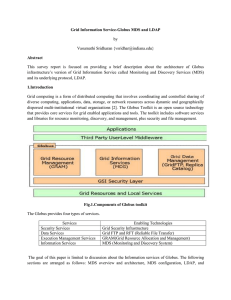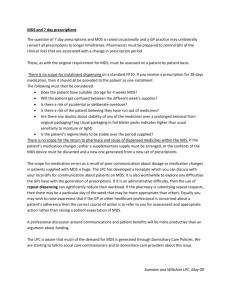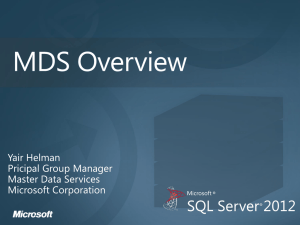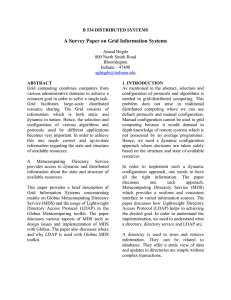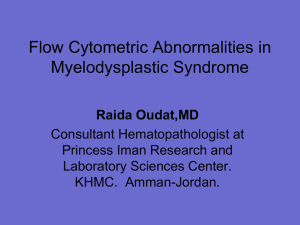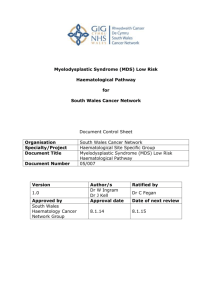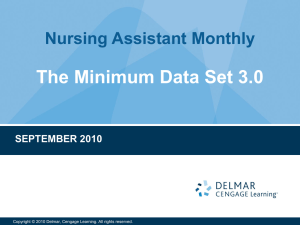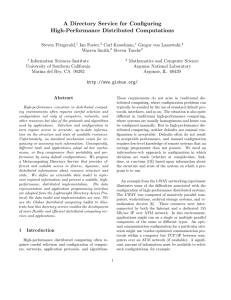Metacomputing Directory Service
advertisement
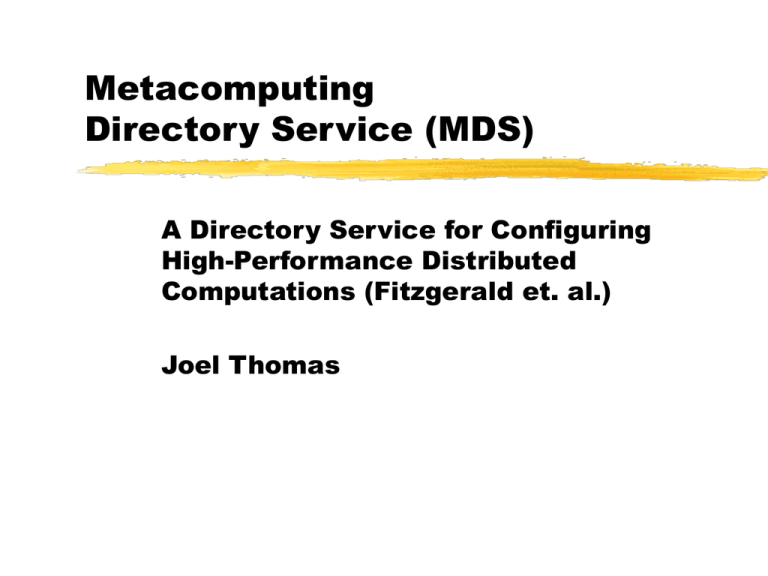
Metacomputing Directory Service (MDS) A Directory Service for Configuring High-Performance Distributed Computations (Fitzgerald et. al.) Joel Thomas Overview Introduction Design Considerations Current Approaches Design of MDS Implementation MDS With Globus Future Conclusion Introduction High performance distributed computing requires selection, configuration To make good decisions, timely, accurate information is invaluable Currently, have nonstandard ways to store/access the right kind of data The Metacomputing Directory Service (MDS) hopes to provide a scalable service to handle this need Design Considerations Performance Scalability and cost Uniformity Expressiveness Extensibility Design Considerations(cont.) Multiple Information Sources Dynamic data Flexible access Security Deployability Decentralized maintenance Current Approaches Uname, sysinfo Simple Network Management Protocol(SNMP), NIS(Network Information Service) PVM(Parallel Virtual Machine), MPICH (Message Passing Interface) DNS (Domain Name Service) X.500, LDAP (Lightweight Directory Access Protocol) Chose to integrate existing systems as much as possible But use LDAP to organize Design of MDS Representation and Data Access Data Model Implementation Representation Borrows straight from LDAP Entry: instance of person, network, computer, etc. Type is created by associating an object class Directory Information Tree (DIT) hierarchical, tree-structured name space Distinguished Name (DN) path from leaf to root entry <hn = dark.mcs.anl.gov ou = MCS, o = Argonne National Laboratory, o = Globus, c = US > DIT example Object Classes LDAP has set of standard class definitions, which can be extended (top, group classes, etc.) Defines attributes for an entry, and what values those attributes may contain Attributes may be required or optional Can use inheritance to build new classes Data Model Consists of DIT hierarchy and object class definitions Computer centric, not network centric People, hosts, communication networks under organization Data Model (cont.) GlobusHost GlobusNetwork Link protocol (ATM, Ethernet) Network topology(bus, ring) Physical media (copper, fiber) GlobusNetworkInterface Physical characteristics (speed) and hardware address Hosts contain network interfaces Network interfaces attached to networks Configuration example MDS representation Data Model (cont.) Physical vs. Logical Network info Single network, multiple protocol stacks Each may have distinct interface and performance Images: multiple logical views of the same physical network (RFC 1609) contains new information, and pointer back to physical Physical has reference to all images that point to it GlobusHostImage GlobusNetworkImage GlobustNetworkInterfaceImage Implementation While LDAP interface met most needs, default implementation was somewhat slow Problems: Single information provider Client/server architecture Scope of Data Allows info providers to provide information per attribute Time to Live (TTL) for attribute (before refreshing) Update scope: process, computation, global Sample queries What are the network interfaces for ATM? Find GlobusNetworkInterface->GlobusNetwork (link_protocol=ATM) For that GNI, GlobusNetworkInterface>GlobusNetworkInterfaceImage (ip_address) Which nodes can use vendor protocols on fast internal networks? Two GlobusHostImages belong to the same GlobusNetworkImage object MDS Recap MDS with Globus Nexus communication module Uses MDS to find out what low-level mechanisms are between modules Select between mechanism, based on rules Rules based on dynamic information or programmer preference Code runs unchanged, but can adapt to meet performance needs I-WAY TestBed (heterogeneous virtual machines) Resource Location Resource Brokers Future Use in GUSTO Extend Globus components to use MDS Expand information sources Optimize for common operations Sophisticated applications (e.g. resource scheduling) Performance metrics Conclusion Designed to provide dynamic information in a timely, scalable manner Take advantage of LDAP flexibility and growing usage in industry Provide information richness in extensible manner
